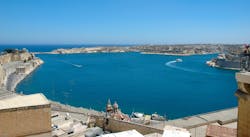Reverse osmosis desalination energy reduced by a third in Malta
Between 2004 and 2013 Malta has managed to reduce the energy consumption of its reverse osmosis (RO) desalination plants by 33%.
Data produced by the National Statistics Office (NSO) in Malta showed that in 2004 the island’s electricity consumption from using RO-based desalination was 101,126 Mwh, making up 4.8% of total electricity consumption.
In 2013 this has decreased to 78,871 Mwh, or 3.7% of Malta’s total electricity supply.
In terms of the amount of energy used to produce one cubic metre of water, in 2004 this was 5.7 Kwh and in 2013 this had dropped to 4.6 Kwh.
The NSO told WWi magazine that the decrease in energy for the RO plants can be mainly attributed to "the decrease in water production in view of the leakage problems" and the "installation of more energy efficient equipment within the plants themselves".
However, the amount of wastewater reused from the Sant’ Antnin wastewater treatment plant decreased over the same period.
In 2004 this was documented at 1.8 million m3 of irrigation effluent reused and 707,108 unused. In 2013 this decreased to 1.1 million m3 of irrigation effluent reused and 782,735 m3 unused.
However the total volume of wastewater treated by the plant fell from 2.6 million m3 in 2004 to 1.9 m3 in 2013. The NSO attributed this to “a reduction in the demand for irrigation water produced by this plant”.
As a result of degraded seawater from increasing concentations of nitrates from fertilizers, Malta has been heavily reliant on seawater desalination.
In 2010 over half (56%) of Malta’s potable water was produced by desalination.
###
- Statistics from the NSO can be found here.
About the Author

Tom Freyberg
Tom Freyberg is an experienced environmental journalist, having worked across a variety of business-to-business titles. Since joining Pennwell in 2010, he has been influential in developing international partnerships for the water brand and has overseen digital developments, including 360 degree video case studies. He has interviewed high level figures, including NYSE CEO’s and Environmental Ministers. A known figure in the global water industry, Tom has chaired and spoken at conferences around the world, from Helsinki, to London and Singapore. An English graduate from Exeter University, Tom completed his PMA journalism training in London.
